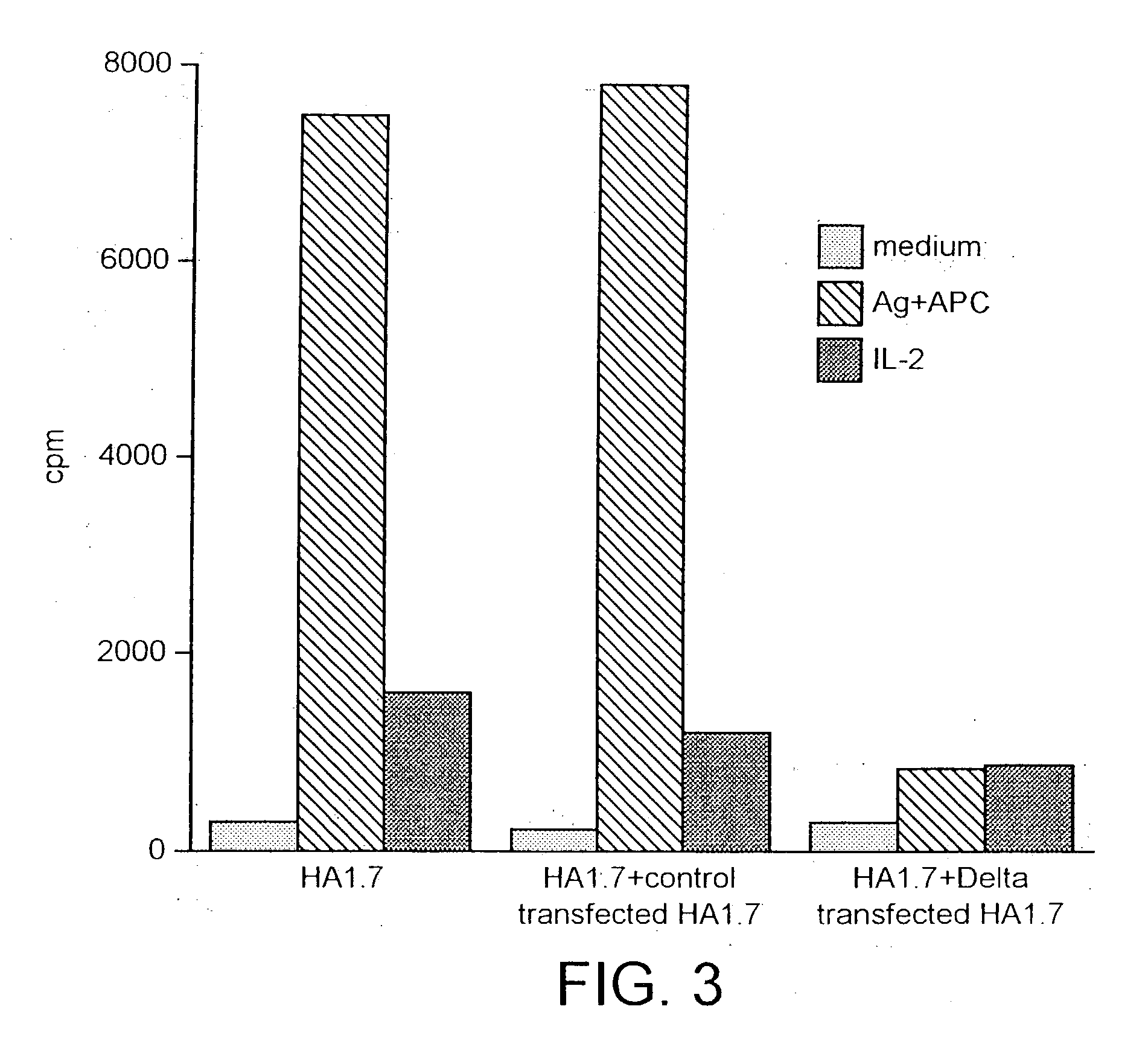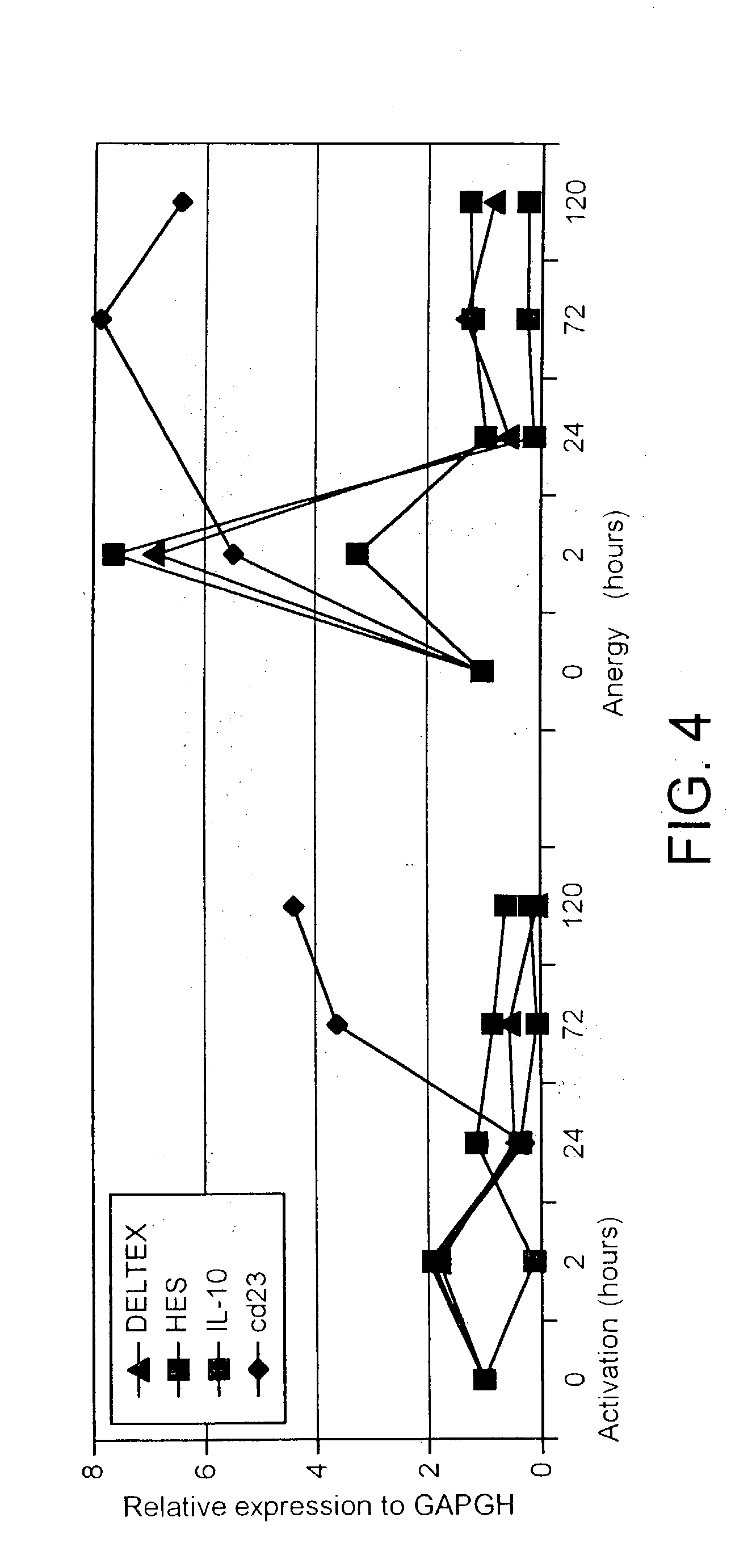Assay
a technology of assay and mrna, applied in the field of assay, can solve problems such as failure to properly regulate tolerance, and achieve the effects of accurate mapping of mrna features, increased fluorescence, and high specific activity
- Summary
- Abstract
- Description
- Claims
- Application Information
AI Technical Summary
Benefits of technology
Problems solved by technology
Method used
Image
Examples
reference example 2
[0234] Induction of Tolerance--Serrate Expression by Antigen Presenting Cells Prevents T-Cell Responses.
[0235] Clone HA1.7 was mixed with peptide HA306-318 (1.0 microgram / ml) in the presence of L cells expressing HLA-DRB1*0101 (as antigen presenting cells), using 2.times.10.sup.4 of each cell type. The L cells were transfected with either control (pure) or serrate (serrate L cells) expressing retrovirus. The proliferative response was measured after 72 hours following addition of tritiated thymidine for the last 8 hours of culture. Results are shown in FIG. 2 for HA1.7 cultures:
[0236] a) alone
[0237] b) +IL-2
[0238] c) +peptide+DRB1*0101-L cells
[0239] d) +peptide+DRB1*0101-L cells transfected with control virus+peptide+DRB1*0101-L cells transfected with serrate virus
[0240] HA1.7 stimulated by serrate expressing L cells responded poorly to antigen when compared with those stimulated by control transfected L cells.
reference example 3
[0241] Induction of Tolerance--Serrate Expressing Antigen Presenting Cells Induce Regulatory T-Cells.
[0242] Clone HA1.7 was mixed with peptide HA306-318 and L cells (expressing DRB1*0101 as antigen presenting cells) in the presence of 2% IL-2. The L cells were transfected with either control or serrate expressing retrovirus. After 7 days in culture, the HA1.7 were harvested washed and irradiated before being mixed with fresh HA1.7 (using 2.times.10.sup.4 each population). Cells were cultured for a further 2 days before being stimulated with peptide (1.0 microgram / ml)+normal antigen presenting cells (DRB1*0101 PBMCs). The proliferative response was measured after 72 hours following addition of tritiated thymidine for the last 8 hours of culture. The results are shown in FIG. 3 for fresh HA1.7 cultured:
[0243] a) alone
[0244] b) +IL-2
[0245] c) +control virus induced HA1.7, then peptide+DRB1*0101 PBMC
[0246] d) +serrate virus induced HA1.7, then peptide+DRB1*0101 PBMC
[0247] HA1.7 induced ...
example 4
[0248] Detection of Tolerance--Notch Signalling Occurs During the Induction of Anergy. HA1.7--concentration of cells 2.times.10.sup.6 / ml; activation conditions were anti-CD3 and anti-CD28 antibody. Anergy conditions were HA306-318 peptide at 25 .mu.g / ml; concentration of peptide 25 .mu.g / ml--was cultured for varying times as indicated in FIG. 4. Total RNA was produced by homogenisation of cells in guanidine isothiocynanate solution and separated over a CsCl gradient. The extracted RNA was subjected to real-time PCR using the following primers and probes:
[0249] HES-1 forward primer: CAT TCT GGA AAT GAC AGT GAA GCA
[0250] HES-1 reverse primer: CAG CGC AGC CGT CAT CT
[0251] HES-1 probe: CTC CGG AAC CTG CAG CGG GC
[0252] Deltex forward primer: TTC CCT CGC CAC TGC TAT CT
[0253] Deltex reverse primer: GAC TCG CCC GTG GTG TTG
[0254] Deltex probe: CCC AAC AAC GAG AAA GGC CGG AA
[0255] In FIG. 4 the expression of genes is shown relative to that of a control gene, GAPDH.
PUM
| Property | Measurement | Unit |
|---|---|---|
| Tm | aaaaa | aaaaa |
| total volume | aaaaa | aaaaa |
| temperature | aaaaa | aaaaa |
Abstract
Description
Claims
Application Information
 Login to View More
Login to View More - R&D
- Intellectual Property
- Life Sciences
- Materials
- Tech Scout
- Unparalleled Data Quality
- Higher Quality Content
- 60% Fewer Hallucinations
Browse by: Latest US Patents, China's latest patents, Technical Efficacy Thesaurus, Application Domain, Technology Topic, Popular Technical Reports.
© 2025 PatSnap. All rights reserved.Legal|Privacy policy|Modern Slavery Act Transparency Statement|Sitemap|About US| Contact US: help@patsnap.com



